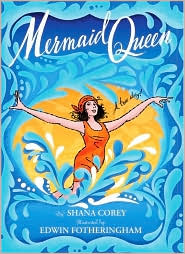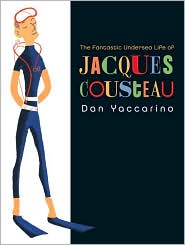 First up is Mermaid Queen: The Spectacular True Story of Annette Kellerman, Who Swam Her Way to Fame, Fortune & Swimsuit History! by Shana Corey, illustrated by Edwin Fotheringham. I'll start with the cover, since that's what had me snatching this up in the first place. The colors are even better than they appear online. The lettering is white, and embossed in very shiny text, and the image of Annette Kellerman is similarly embossed on the cover, as are the whit parts of the waves, which adds both a fun feel and way more "pop" to the cover than is conveyed by pixels. Oh pixels, why do you let us down so?
First up is Mermaid Queen: The Spectacular True Story of Annette Kellerman, Who Swam Her Way to Fame, Fortune & Swimsuit History! by Shana Corey, illustrated by Edwin Fotheringham. I'll start with the cover, since that's what had me snatching this up in the first place. The colors are even better than they appear online. The lettering is white, and embossed in very shiny text, and the image of Annette Kellerman is similarly embossed on the cover, as are the whit parts of the waves, which adds both a fun feel and way more "pop" to the cover than is conveyed by pixels. Oh pixels, why do you let us down so?Annette Kellerman was born in Australia to parents who were music teachers, and who had a house full of music and dance students. Annette wanted to dance, but alas, she had a health condition that affected her legs and caused her to wear heavy braces. A doctor recommended that she swim in order to strengthen them, and it worked. Annette felt graceful in the water. In addition to swimming laps and racing, she "whirled and twirled. She dipped and danced and dived." In point of fact, she invented water ballet.

Annette became a performer, leaving Australia for England to display her prowess, where she couldn't get booked at first because she was a woman. Stunts like swimming in the Thames and trying to swim across the Channel to France got her noticed. She was invited to perform for Royalty at the Bath Club, and Annette "the Mermaid Queen" rapidly became popular throughout Europe.

Her fame spread, and Annette was invited to swim in Boston. Annette turned up in her swim gear that showed her legs only to find that American women bathers were still wearing what amounted to full clothing. (I have a tintype of my great-great-grandparents and their friends in swim wear, and I can assure you that the men look very handsome in their striped sleeveless unitards and the women look overdressed in frilly bathing dresses, bloomers, stockings, shoes and hats.)

Annette was arrested for wearing her more form-fitting bathing suit (that showed her legs, no less). I wish that spread were available online: Fotheringham has cleverly done it as if the artist were out in the water, watching Annette enter. The background is therefore in the shades of orange that are on Annette's suit and around her on the cover, and her suit is two-toned blue like the cover's background. It's all completely made of awesome. But I digress. Annette managed to persuade the judge that attempting to swim in all the many layers of clothing women were wearing at the time was not only difficult, but also potentially dangerous, and she was allowed to proceed. Eventually, other American women followed suit and began wearing swimgear that more resembled Annette's kit.
In addition to a wonderfully understandable account of Annette's story, there's a three-page Author's Note at the end that more fully recounts Annette Kellerman's story as well as explaining why Shana Corey was so drawn to write about her in the first place. "What drew me most to Annette, though, wasn't that she succeeded at so many things - but that she didn't always succeed. Still, she was brave and determined enough to keep trying, even when the rest of the world was telling her not to. To me, that sort of conviction - the courage to believe in yourself even when others doubt you - is one of the most difficult and bravest things of all." Preach it, Shana! Can I get a "you go, girl"?
The Acknowledgments at the back of the book double as a bibliography as well, including as it does the names of researchers and biographers on whose work Corey relied, and listing the sources of specific quotes found throughout the book (including newspapers and other sources).
 Next up is The Fantastic Undersea Life of Jacques Cousteau by Dan Yaccarino. Again, it was the cover that had me snatching this up in the first instance. I wish I were better able to explain what it is about the art that appeals to me, but alas, I shall just have to wing it, never having learned the proper terms, really. I liked the black and white bits, of course, but it was the style of the image of Cousteau and the colors and jumbled style of the letters that made this cover pop for me.
Next up is The Fantastic Undersea Life of Jacques Cousteau by Dan Yaccarino. Again, it was the cover that had me snatching this up in the first instance. I wish I were better able to explain what it is about the art that appeals to me, but alas, I shall just have to wing it, never having learned the proper terms, really. I liked the black and white bits, of course, but it was the style of the image of Cousteau and the colors and jumbled style of the letters that made this cover pop for me.Yaccarino begins Cousteau's story with a two-page spread showing the adult Cousteau scuba diving over a coral reef. Boy, do I wish I could find that image online for you so you could see how the light plays in that image, but alas I cannot. The text reads "Jacques Cousteau loved the sea. He spent his whole life exploring it. The ocean was the most incredible place he'd ever seen, and he wanted to shar its beauty with the world." Also included in the spread is a small round sidebar (sidecircle?) that includes this lovely quote from Cousteau himself: "The sea, once it casts its spell, holds one in its net of wonder forever." Dear Mr. Yaccarino: You had me at this two-page spread. *swoon*
Cousteau, as it turned out, was weak and sickly as a child, and was encouraged by doctors to swim in order to build up his strength. Like Annette Kellerman, he discovered an affinity for the water. Cousteau also tinkered with machinery and cameras. As a young man, Cousteau was injured in a car accident, and told he'd need arm braces. He returned to the water of the Mediterranean for rehabilitation, and a pair of goggles from a friend changed his life forever.
Wanting to stay under water longer (and to be unconfined by the heavy diving suits of his day), Cousteau and his friend Emile Gagnan invented the Aqua Lung to allow a diver to stay underwater and have some freedom of movement.

In addition to working to develop the Aqua Lung, Cousteau also made advances in underwater lighting and cameras to allow filming below the water's surface. Says another Cousteau quote circle, "It fascinated me to do something that seemed impossible." The following image from Dan Yaccarino's website is NOT in the book, but is similar in coloring and technique to what's there:

Cousteau bought his boat, the Calypso, and sailed the sea engaged in research and filming. He shot The Silent World, the first full-length, full-color underwater film ever made. To obtain still better diving ability, Cousteau and his team invented the Diving Saucer and the Sea Flea, mini-subs that allowed one or two men to go still deeper below the ocean's surface to learn more about the sea. He explored the waters of Antarctica (about that continent, he said "May this continent, the last explored by humankind, be the first one to be spared by humankind.")
Cousteau invented underwater labs, wondering if people could actually live underwater, but he found that it wasn't practicable. Mention is made of his books, films, and his TV series (which I remember watching as a kid), The Undersea World of Jacques Cousteau. In addition to being the oceans' ambassador, Cousteau became an ecological crusader. He founded the Cousteau Society, which has educational and ecological aims. Again, the following image is NOT in the book, but is similar in style to what's there:

At the end of the book is an annotated timeline presenting important events in Cousteau's life as well as a selected bibliography.
Both books present colorful, eye-popping illustrations that ground the reader in the story (sorry for the landlocked reference, but really, despite being watery tales, the reader is never cut adrift by the text or illustrations in these two books). The images enhance and add to the texts, both of which relate their stories in terms that will appeal to child readers. Both books tell the story of pioneers - Annette being a pioneer for women's rights, Cousteau for sea exploration. Both tell the story of children who overcame physical limitations through swimming, who invented new things (the sport of water ballet in one case, and a host of machines in the other) to allow for greater appreciation of the water. And both tell the story of people who were devoted to the idea of education and of shaking off limitations.
As you can probably guess from my purchase and my review, I can't pick just one. And neither should you. I hope you'll seek them both out for their inspirational stories and their excellent artwork. You won't regret it.

3 comments:
The cover of the Cousteau book reminds me of an advertisement for a play--very artsy. This post leaves me wondering if the same text was used for two different books, one with photographs and one with illustrations, would one captivate children for a longer time. As a reader, I think I'd be more apt to spend additional time leafing through a beautifully illustrated book versus a book with photographs, but perhaps that is just me and the nonfiction books I've read. What do you think?
Since I completely agree with you that Mermaid Queen is "made of awesome" (Edwin Fotheringham's illustrations made me swoon when I read it), I now can't wait to get a copy of Yaccarino's book. I had heard of it, but seen no more than the cover. Thanks for the inside scoop- the illustrations are amazing!
Boni: I'm glad you agree about Mermaid Queen. You will almost certainly love Dan Yaccarino's book as well - some of the artwork I shared is from his website, and is not "from" the book, but is decidedly in the style of the book.
Linda: The text of the Cousteau book is well-written, but I have to say that the illustrated version tells the story in a far more unified way than actual photos would. Whether actual photos of Cousteau exist that would illustrate the particular details that Yaccarino shared is just one factor, to say nothing of permissions. Also, I'd guess that a lot of photos of Cousteau as a child and young man (even if they exist) would be black & white, and possibly of questionable quality, which might not hold a child's interest well - and certainly couldn't compete with the extremely colorful illustrations that Dan Yaccarino created.
Post a Comment